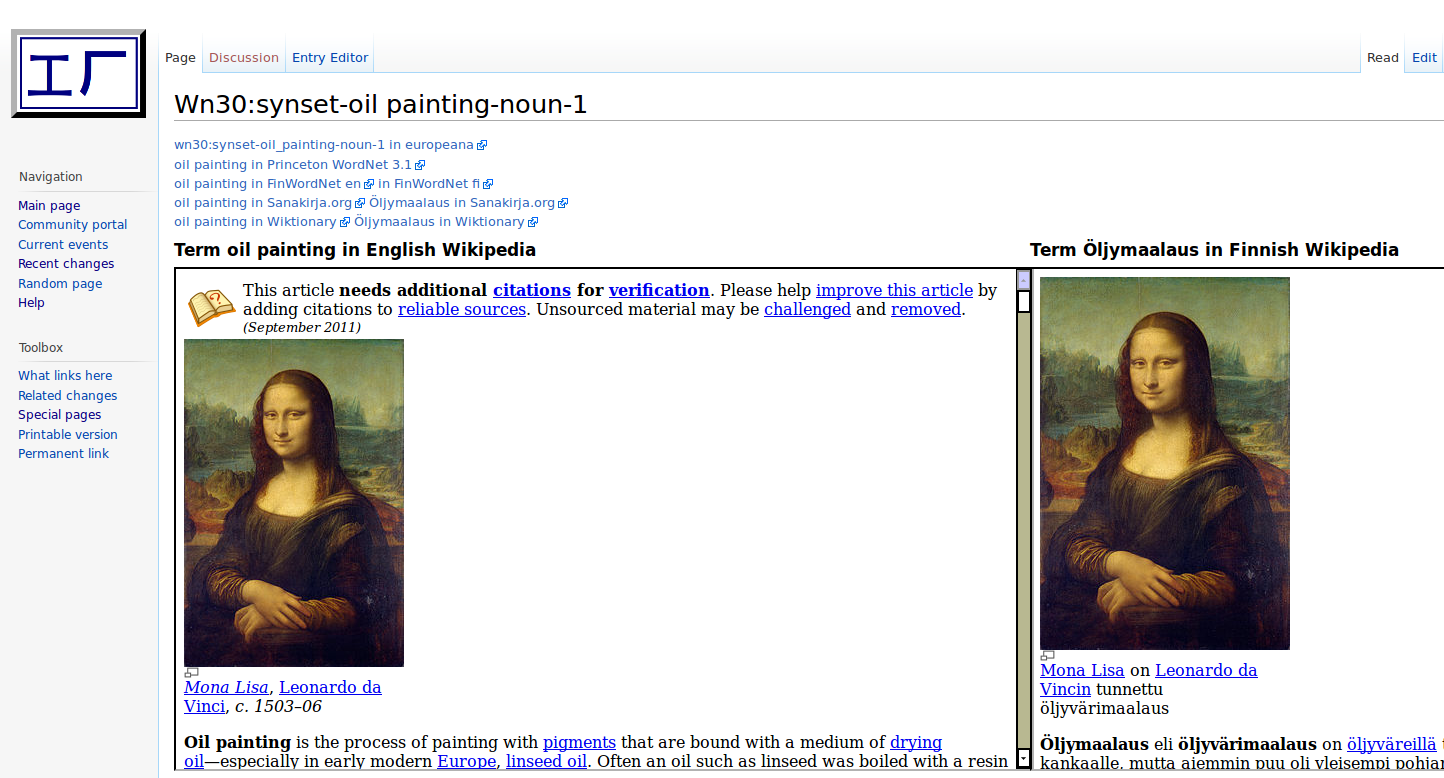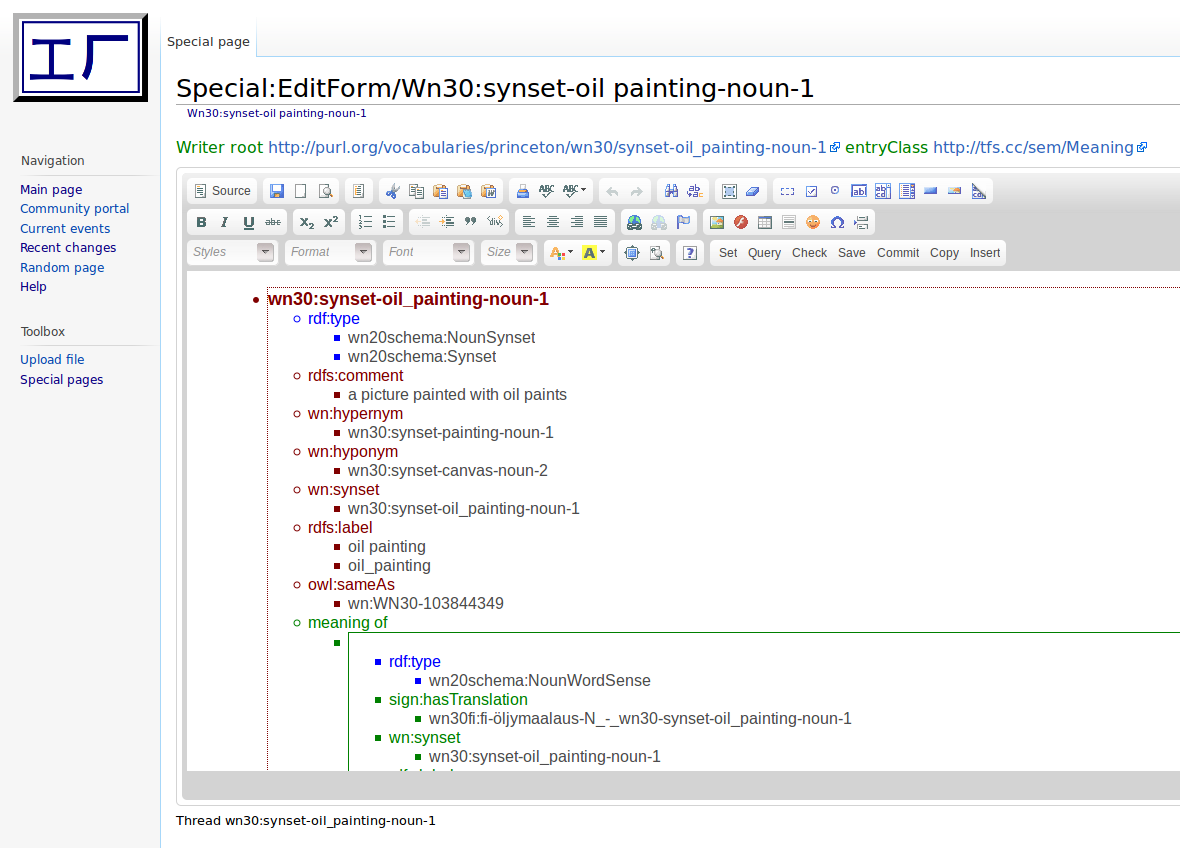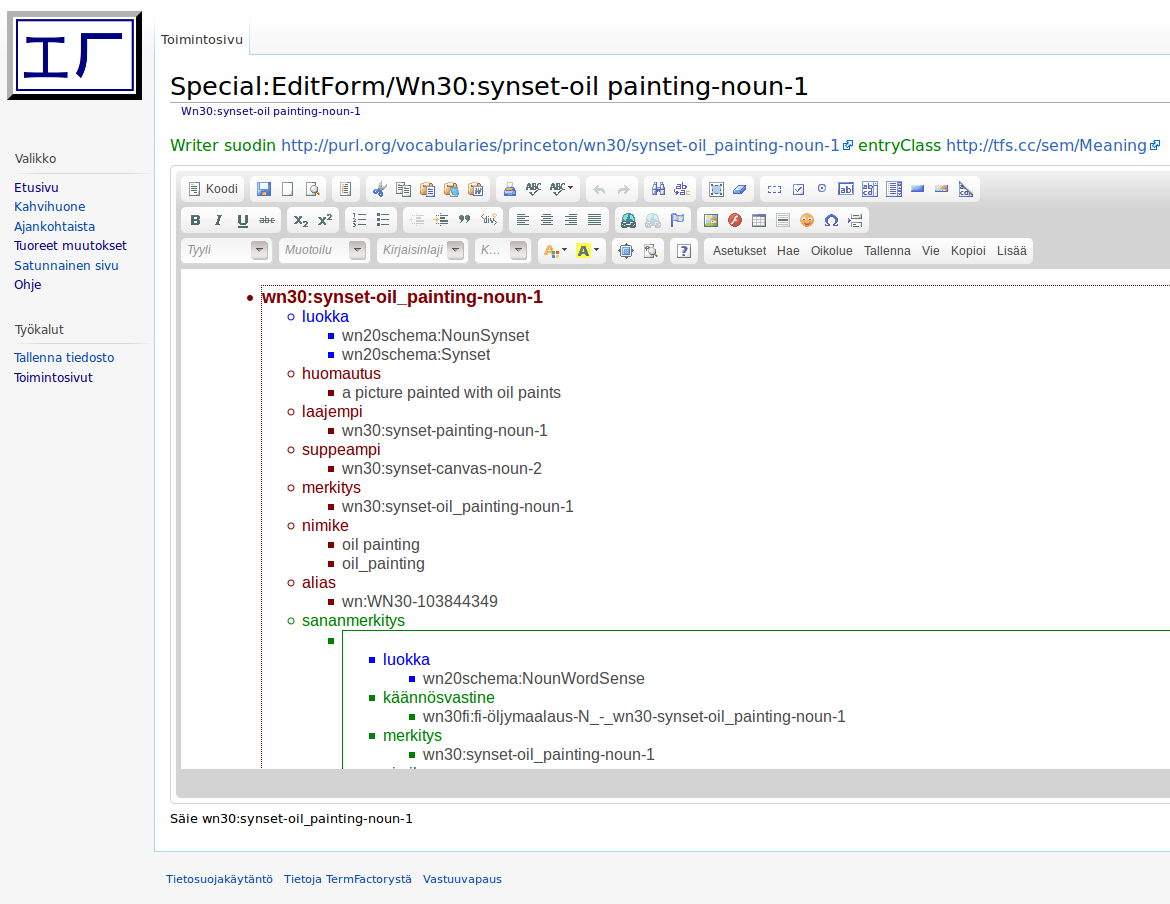3.4 TermFactory
The MOLTO TermFactory prototype consists of the generic TermFactory codebase plus MOLTO related ontology content. At present, such content comprises the English-Finnish WordNet ontology. Integration of the TermFactory back-end with the MOLTO KRI over JMS is underway.
The TermFactory codebase consists of
- a term ontology query/editing back end run as an Axis2 Tomcat web service
- a Tomcat webapp that provides standalone term ontology query form and editor
- a MediaWiki installation with a TermFactory editor extension
- a link to the Disqus comment system
TermFactory is an architecture and a workflow for Semantic Web based, multilingual, collaborative terminology work. What this means in practice is that it applies Semantic Web and other document and language technology standards to the representation of multilingual special language terms and the related concepts, and provides a plan for how such terminologies can be collected, updated, and agreed about by professionals, not only terminology professionals, all over the globe, during their everyday work on virtual work platforms over the web. As a whole, TF could be termed a semantic web framework for multilingual terminology work.
TF provides
- ontology and terminology formats
- format conversions
- query and edit tools
- repositories
- web services
for people to work on terms jointly or separately, building on the results of the work of others, while maintaining quality and consistency between the different contributions.
As a prototype, there is a MediaWiki platform for human to human collaboration on collectiong terminological data plus a TF editor plugin for conveying the results of the collaboration into TermFactory ontology format. Here is a snapshot of a random MOLTO TF concept in the Wiki.

3.4.1 Use
MOLTO TermFactory Mediawiki is used in the usual way a wiki works. In the demo prototype, it has been populated with the Finnish-English Wordnet (ca. 100K concepts, 2 languages, ca. 200K terms per language). The pages are generated automatically on demand. A Wordnet page currently only consists of a set of iframes and links to related lexical resources on the web. In actual use, each category (Wordnet is one) may generate its own boilerplate page design to help users describe and discuss the concepts of a category and their designations in different languages. A commenting system is in place that can be shared between different platforms and applications. The discussion threads are indexed by the URI of the relevant resource.
The TermFactory ontology content related to a resource can be queried and edited on the Mediawiki platform using a TermFactory ontology editor extension, shown on top of the page as the Entry Editor tab. Below is a snapshot showing the TF editor opened to the TermFactory entry corresponding to the chosen WordNet term.

Instead of going by way of fill-in forms, the TermFactory approach is to support direct WYSIWYG editing of localized ontology triples in a HTML textarea editor. The TermFactory editor application uses the CKEditor javascript textarea editor for this purpose. TF adds to the CKEditor standard release a special purpose plugin that adds TermFactory specific action buttons and a menu to the standard issue.
While staying conceptually close to the original RDF format of the data, the TermFactory editor layout is quite versatile. With suitable parameters, it can be tweaked to show ontology content editable in shapes already familiar to professional terminologists. There is a customisable, schema-aware insertion menu to help inserting relevant content, plus customisable input and output layout templates. The editor is not limited to TermFactory ontologies, as it is built on a general purpose textarea editor using a generic RDF to HTML mapping.
A specialty of TermFactory is that it supports terminological reflexion. The metaterminology used in the editor is not fixed, but can be changed by giving it a TF term ontology as parameter. Using TF localization and bridge ontologies, not only the editor interface, but also the content shown can be localized to a user community's conceptualization, language and terminology. Here is the same editor page fetched after setting Mediawiki language settings set to Finnish. Note how the terminological metalanguage used in the entry is now shown in Finnish. (The localization is not complete, because the current localization ontology's coverage has some gaps.)

3.4.2 Installation
The TermFactory source code is on svn at svn.it.helsinki.fi/repos/termfactory. A username and password on the repository server is needed for checkout.
To check out a path, choose installation directory, go to it and do
svn checkout https://<username>@svn.it.helsinki.fi/repos/termfactory/path
.
The compiled web archive files for TF are
io/lib/tf-io.jar The core library (offline tools) ws/service/TFServices.aar The Axis2 webservice archive ws/servlet/TermFactory.war The Tomcat webapp archive
These three archives should be enough for deployment of TF in Linux from binaries on Tomcat running Axis2. Installations of mysql and Jena TDB are needed for persistent storage of ontologies on the TermFactory server. File upload services require prior installation of WebDAV. Detailed TF source build and install instructions are available on request.
TermFactory MediaWiki is MediaWiki out of the box plus the TermFactory MediaWiki extension, downloadable from the TermFactory svn path fe/TermFactory. The extension requires installing TF back end, of course.
- Install MediaWiki 1.16 (or newer)
- Put everything under extensions/TermFactory
- Add
require("$IP/extensions/TermFactory/TermFactory.php");to LocalSettings.php in the main directory - go to page Special:EditTerm
3.4.3 Limitations
User management between MediaWiki, TermFactory services, and TermFactory WebDAV is not fully in synch yet.